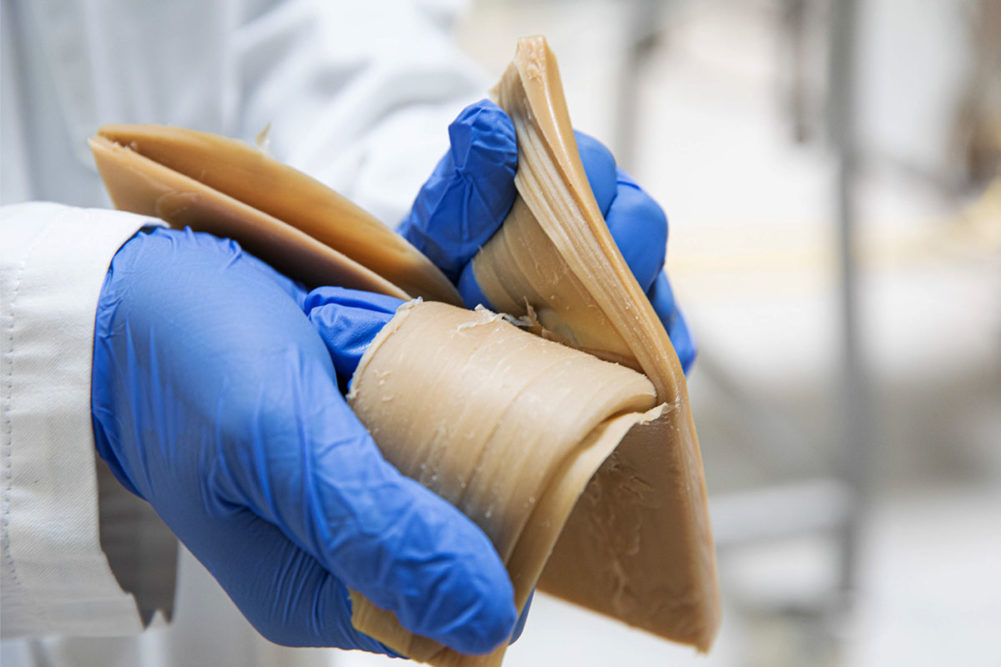This article was published in the December 2021 issue of Pet Food Processing. Read it and other articles from this issue in our December digital edition.
Sustainability has been called one of today’s biggest challenges and one of its biggest opportunities. In response to messages of dwindling natural resources, consumers are demonstrating a growing sophistication about the topic of sustainability, according to The Hartman Group, a Bellevue, Wash.-based provider of trends and resource information.
For many, this translates into growing interest in animal protein alternatives, with calls for transparency regarding sourcing and production and questions about the ethical and ecological impact of purchase. Minneapolis-based Bühler states by 2050, it’s estimated an extra 265 million tons of protein will be needed to meet the demands of the world’s growing population.
Often less expensive than meat and more environmentally friendly, plant-derived proteins possess a longer shelf life and lower fat content. Consumers open to adopting a vegan, vegetarian and/or hybrid (less meat and more plants) diet for themselves are more likely to provide a similar diet for a family pet – paying as much attention to the ingredient list of their pet’s food as they do their own.
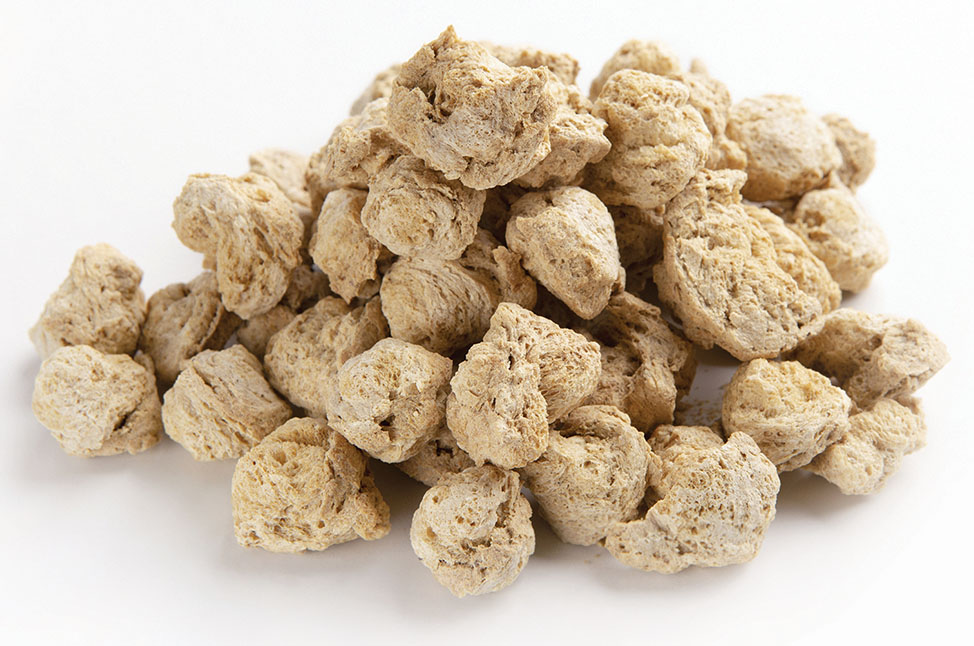
These products fit the bill of being sensorily acceptable to an animal and its owner, despite humans and pets perceiving smell and taste differently. Sustainable texturized proteins possess a long shelf life and can be produced as a meat substitute or meat extender in a variety of shapes, colors and textures with the possibility of a wide range of tastes using adjustments with added flavors.
Profile to build upon
Makers of texturized proteins strive to manufacture products with a high protein content, neutral palatability and functional properties to create a fibrous texture. Produced by extrusion, the twin-screw technology often used in its production provides manufacturers with parameters that can be adjusted and optimized to obtain specific product characteristics. This includes screw and temperature profile, mechanical energy and the design of the die.
Favorable characteristics when producing texturized protein include a protein content that’s usually higher than 50%, protein quality and functionality that allows protein to texturize, and particle size ideally between 100-500 µm – all with an end goal of producing a finished product with the desired texture, shape, color and taste. The range of natural plant proteins also provides nutritional variety and presents an environmentally friendly source of protein at less expense than meat, poultry or fish.
Mix to combine
In the production of dry-textured protein, dry, protein-based ingredients of various functionalities and nutritional compositions are mixed with liquids in a preconditioner to densify the raw material and create a paste. The high-moisture extrusion of plant-based proteins is used to convert plant proteins into food products.
Bühler provides extruding processes that can modify the molecular structure of plant-based proteins to meet desired texture needs. Proteins made of soy, oilseed, pulses, microalgae and insects can be premixed with additional ingredients such as flours, food colorants, flavorings, minerals and emulsifiers before being conditioned and extruded. Bühler’s new cooling die can produce wet textured proteins from soy, sunflower, beans, peas, gluten and other materials at a throughput of 500 kg per hour.
“Texturized protein can offer consistent product quality with which animal derivatives cannot compete,” said Christopher Busch, Crespel & Deiters Group.
Wenger, Sabetha, Kan., offers systems to produce texturized protein products made of soy, wheat gluten base, pea lupin, lentil and legume. Because the base ingredients for dry texturized vegetable protein products are naturally dry and porous, they must be soaked in liquid before being combined in a co-rotating twin screw extruder to deliver the right texture and shape. Traditional texturized vegetable proteins are extruded at less than 30% moisture and further dried to below 10% moisture.
Trigea, a part of Crespel & Deiters Group, Ibbenbüren, Germany, produces wheat-based texturized proteins from the Trigovit® Tex range that replicate the textures of many meats, including fish. These texturized proteins are available as chunks, flakes, granules, fibers and in powdered form.
The Trigea product offers an array of functionality, especially in terms of sensory properties and safety. The wheat-based texturized proteins improve the texture and stability of a variety of applications, including in vegan and vegetarian pet food. Manufacturers can also process the taste-neutral, preservative-free products with meat to create hybrid options with improved nutritional value and stability. The versatile product finds use in dry kibble as a fibrous component, an addition to pet treats, and can function as the solid particles in semi-moist applications and provide a firm texture to wet pet food.
“Texturized protein can offer consistent product quality with which animal derivatives cannot compete,” said Christopher Busch, head of R&D extruded products, Crespel & Deiters Group.
Blending textures
Understanding the challenge for wet applications lies in finding the right texture, Trigea provides textured vegetable protein (TVP) as dry products that can be individually hydrated. The firmness of the product can be adapted so it matches the requirements, depending on the ratio of water to dry texturate.
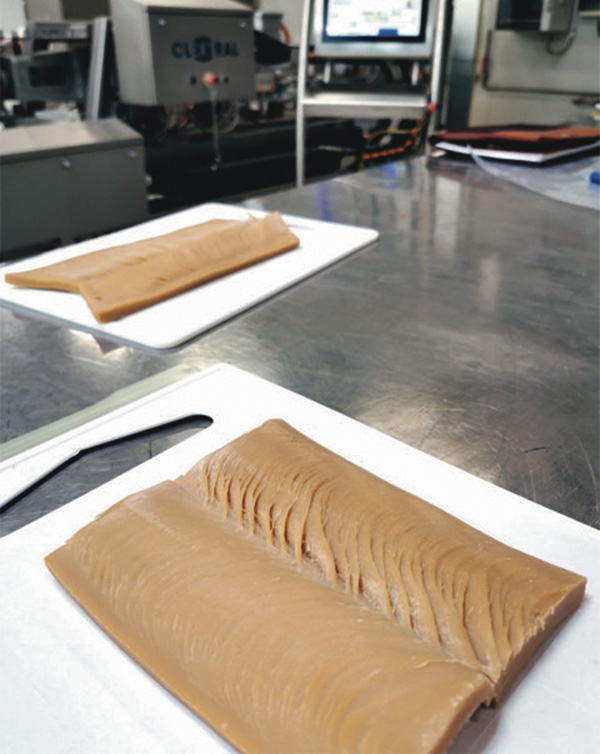 The combination of the formulation, extrusion system, die plate and drying obtain an optimal texturization of the product, which will then typically become a component of a final pet food formula. (Source: Clextral)
The combination of the formulation, extrusion system, die plate and drying obtain an optimal texturization of the product, which will then typically become a component of a final pet food formula. (Source: Clextral)
Tampa, Fla.-based Clextral USA offers two processes to convert protein ingredients into meat analogues for pet food. The dry meat analogue is used as an extender, rehydrated up to 50% to 60% moisture, and blended with meat or other ingredients. The High Moisture Extrusion (HME) creates a wet meat analogue with the texture and mouthfeel of meat.
After combining, the paste is conveyed to a twin-screw extruder where it is processed thermo-mechanically. Through a change in the process parameters of the complex thermo-mechanical process, manufacturers can influence the shape, taste, nutritional composition, color, bulk density and strength.
“This process allows proteins to be denatured, deactivates certain enzymes that cause rancidity, destroys growth inhibitors and reduces bitterness and off-flavors,” explained Julie Prost, process engineer and test plant manager, Clextral.
The mix then goes through the die where protein macromolecules are cross-linked to form a cell-based structure and to size the final extrudate. Product texture is further determined by laminar shearing of the protein and evaporation, and a rotating blade cuts the product as it comes out of the die. Product is then dried to reach 10% or less moisture content to complete the process. Once cooled, it is packaged and sold as an ingredient or directly rehydrated and incorporated into complete meals.
Wet components
Wet analogues are made with texturized vegetable proteins and processed in wet extrusion and can be easily integrated to improve the visual appearance of wet pet food. These wet meat analogues typically run at high moisture levels between 50% and 70%.
After mixing in a dry or wet mixer, the mix is conveyed or pumped to a twin-screw extruder where it is thermo-mechanically processed at a temperature of about 140 C (284 F) and under a high level of moisture content (60% to 80%).
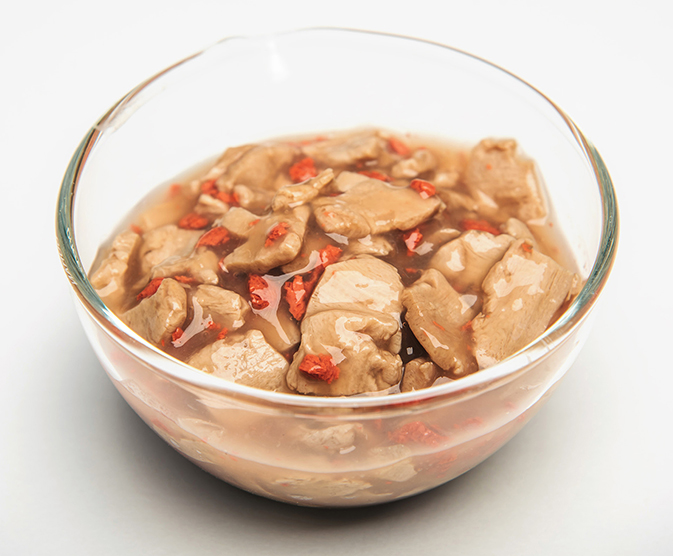 An important benefit of these extruded, meat-alternative ingredients in wet pet food applications is the product stability throughout shelf life. (Source: Crespel & Deiters Group)
An important benefit of these extruded, meat-alternative ingredients in wet pet food applications is the product stability throughout shelf life. (Source: Crespel & Deiters Group)High functionality of the proteins is required to obtain optimal fibration, or texturization, in a long cooling die. Using twin-screw technology, the fibrated materials are post-processed into cubes, slices or shredded pieces for wet pet foods. These cost-effective alternatives can mimic high-quality meat in premium pet food at a fraction of the cost of whole-muscle meat while providing a balanced nutritional profile.
In wet applications, Roquette, Lestrem, France, uses its neutral-profile, highly purified VITEN® Vital Wheat Gluten & NUTRALYS® pea protein to create the requested fibers through extrusion, mimicking the muscle of meat.
When texturizing vital wheat gluten or pea protein, the key factors are pressure, heating and cooling temperatures. Depending on nutritional targets, the main challenge is being able to develop the fibrous texture and to make it resistant to sterilization, according to the Roquette Animal Nutrition team. These products can also be easily complemented with amino acids, vitamins or minerals.
“We foresee great development in the future in wet pet food from wet extrusion,” shared members of the Roquette Animal Nutrition Team. “Today, we observe the emergence of new wet formats such as soups, stews and purées as the pet food market follows the larger food revolution toward plant-based foods that are more sustainable.”
Plant-based high-moisture meat analogues (HMMA) produced using Wenger technology also mimic whole muscle meat. HMMA, which contains 50% to 80% moisture after extrusion, can be created to exhibit similar characteristics to animal protein in relation to moisture, protein and fat content, and feature a densely layered, somewhat fibrous structure.
Wenger’s ST Series twin screw extruders are used to produce anything from simple meat extenders to highly engineered meat analogues, incorporating features that promote automation, enhanced versatility and improved output-to-energy ratios while allowing for simplified maintenance that can increase the life of critical screw and barrel components.
“Many more product innovations are bound to come onto the market as the potential for extrudates is far from exhausted,” said Christopher Busch, Crespel & Deiters Group.
“Through further development and research into extrusion technology, many more product innovations are bound to come onto the market as the potential for extrudates is far from exhausted,” Busch predicted. “In the future, in the sense of the circular economy and the goal of a zero-waste industry, the use of co-products will certainly become more important.”
Small amount, big impact
Although playing a minor role in the recipe ratio, flavor enhancers and preservatives play a major role in the taste, texture and color of the finished product. These components are integral in tailoring foods for specific pets and breeds and making these products appealing to pets and their owners.
To create a more meat-like texture and appearance in foods, Fiberstar, Inc., River Falls, Wis., produces a texturizing citrus fiber, Citri-Fi® TX20, that binds significantly more water and retains firmness when combined with texturized proteins in pet food applications. The standard Citri-Fi 100 lines provide high water holding and emulsification properties.
At low usage levels (less than 1%) this natural ingredient binds oil and water to improve moisture retention and boost stability and quality over time when used with texturized proteins. The high surface area of the fiber structures provides strength, which benefits handling and forming to reduce breakage during processing and storage. Depending on the amount of binding, firmness and strengthening desired, the usage level of Citri-Fi ranges between 0.5% and 4%.
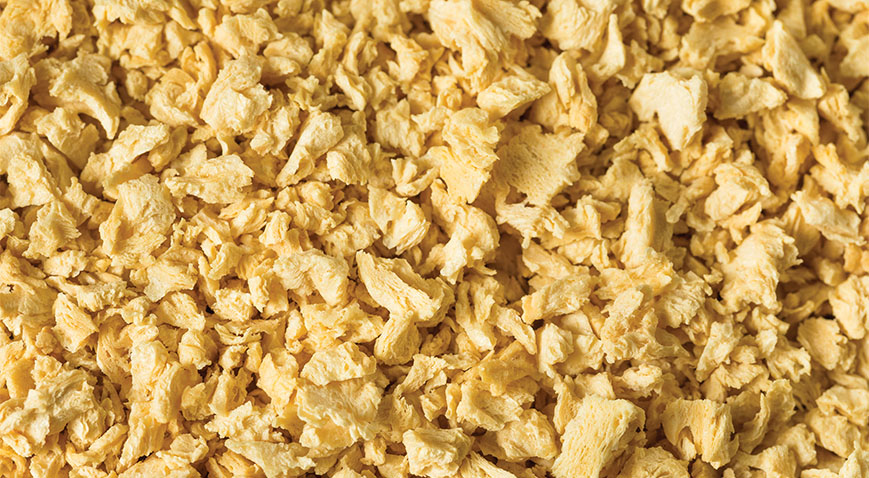 Texturized protein alternatives can be made from a wide range of ingredients including grain, algae, insects and vegetables. (Source: ©BRENT HOFACKER - STOCK.ADOBE.COM)
Texturized protein alternatives can be made from a wide range of ingredients including grain, algae, insects and vegetables. (Source: ©BRENT HOFACKER - STOCK.ADOBE.COM)When used at the recommended usage rates, it can increase cold strength by 55% and hot strength by 33% while maintaining a pleasant mouthfeel and texture. The heat tolerance of this natural texturizer also means it will help retain water and absorb any moisture given up by less heat-tolerant ingredients. Citri-Fi can also be used with many other binding ingredients that provide thermal gelation for additional firmness after cooking and/or baking.
Ongoing impact
Much like the continuing interest in sustainability, the market for texturized proteins is also booming. The popularity and versatility of texturized protein continues to usher in the availability of many more diverse protein ingredients that offer new opportunities for incorporating these plant-based products in recipes, Prost said.
These efforts include the teaming of global companies to develop new solutions for more sustainable protein production, such as the January 2021 partnership between Bühler and the German Institute of Food Technologists. The technology center in Quakenbrück, Germany, provides research, testing and production infrastructure for the development of new production technologies for healthy and sustainable food products, focusing on alternative protein-based products with a lower environmental impact than found along the carbon dioxide-heavy meat value chain.
The companies noted that a key technology to unlock this opportunity is extrusion. Highly versatile, it enables the formation of texturized proteins with different structures from different raw materials.
“Alternative proteins are a big step toward sustainable products,” Busch concluded. “This is highly appreciated by consumers but also needs to be on the agenda of all food or feed manufacturers going forward.”
Read more about product development, ingredients and formulation.
